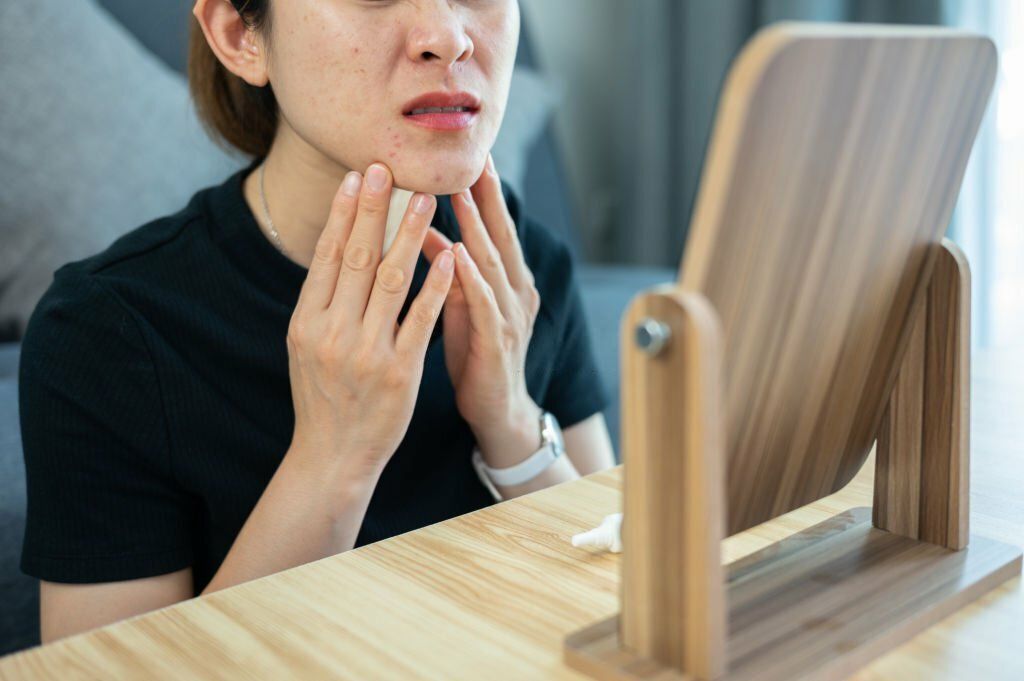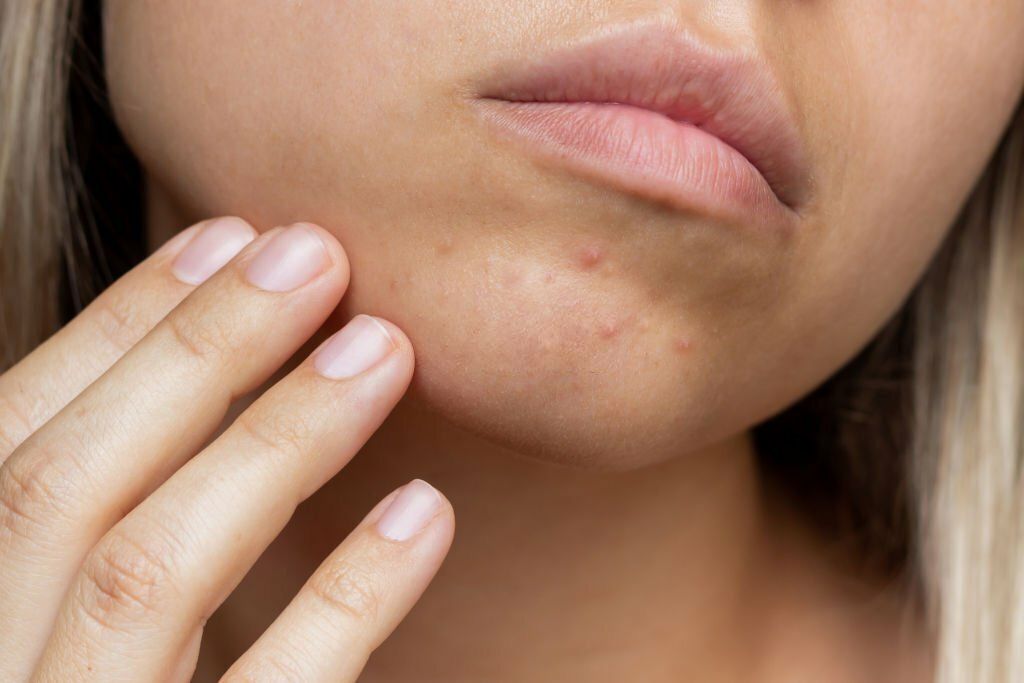This article is reviewed, corrected, and approved by: Julia Weiss CNP| RN | MPH
Have you ever noticed any red spots or rash beside your mouth or in the face? At first, it looks like an ordinary pimple, but it's not. These are common cases of Perioral Dermatitis, which is mistaken for acne or eczema.
But unlike those conditions, it does not involve the central part of the face. This skin condition that primarily affects the area around the mouth but can also spread to the nose and eyes.
Today, I am going to talk about perioral dermatitis and signs perioral dermatitis is healing. Moreover, I will also discuss causes, symptoms, treatment, and more.
What is Perioral Dermatitis?
So, there's this skin condition called perioral dermatitis. It's a hassle because it makes these annoying little red bumps or pimples pop up around your mouth. Sometimes, they can also show up near your nose and eyes.
It mainly affects the face and is more common in women than men. This condition is also known as muzzle rash.
Causes of Perioral Dermatitis
This condition is more common in women than men, and it usually affects people between 20 and 45 years old. The specific etiology or the cause of perioral dermatitis is unknown. However, various factors have been identified that could contribute to its onset. These include:
- Topical corticosteroids: The prolonged use of steroid creams or ointments on the face can result in developing perioral dermatitis.
- Fluorinated toothpaste: Certain toothpaste brands contain fluoride, which has been linked to dermatitis in some individuals.
- Heavy moisturizers: Thick creams and ointments may cause perioral dermatitis by clogging pores.
- Harsh facial cleansers: Harsh cleansers or scrubs might harm skin and the body's natural balance and development.
Common Symptoms of Perioral Dermatitis

The signs of perioral dermatitis can vary from person to person. Here are some common symptoms
- Redness and inflammation around the mouth
- Pus-filled bumps and papules
- Dry and flaky skin
- Mild itching or burning sensation
Treatment of Perioral Dermatitis
Treating this dermatitis often involves a combination of lifestyle changes and medications. Some common treatment options include:
- Avoiding the use of topical corticosteroids
- Switching to fluoride-free toothpaste
- Using gentle and non-comedogenic moisturizers and skincare products
- Wash your face using mild, fragrance-free cleansers and care products
- Prescription medications, such as topical antibiotics or oral antibiotics
Dealing with such dermatitis near the mouth area requires special care and attention. It's essential to use sunscreen formulated to be gentle on sensitive skin to protect your face. While tea tree oil may have potential benefits, it's crucial to be cautious when using it on your face, as it can be unpleasant to some people.
When it comes to treating perioral dermatitis in a child. It's advisable to consult with a pediatrician or dermatologist for guidance. They can recommend specific diaper rash creams that are safe and suitable for managing this condition in children.
It is essential to follow your dermatologist's advice and complete the full course of treatment to ensure effective healing.
Signs Perioral Dermatitis is Healing

Recognizing the signs of healing is crucial in managing perioral dermatitis ICD 10 and restoring your skin's health. Some common signs your perioral dermatitis is healing include:
- Redness and inflammation subsiding
- Red bumps and papules shrinking in size
- Improved skin texture and smoothness
- Reduction in itching or burning sensation
It is important to note that healing may take time, and individual results may vary. Patience and consistent adherence to the treatment plan are key to achieving successful healing.
How To Treat Perioral Dermatitis At Home?
Home care strategies for managing oral region dermatitis include
- Identifying and eliminating triggers
- Gentle cleansing using essential oils like perioral dermatitis tea tree oil
- Avoiding overwashing as it triggers perioral dermatitis, moisturize with caution
- Refraining from touching the affected area to prevent contact dermatitis
- Protecting your skin from the sun. You can use perioral dermatitis sunscreen.
- Paying attention to your diet.
- Managing stress, staying hydrated. You can often drink apple cider vinegar, which has immense anti inflammatory properties
- Avoiding the use of topical steroids without medical guidance as it has side effects of causing dermatitis (perioral).
While these measures can be helpful for mild cases. Severe or persistent cases require medical treatment from a dermatologist or healthcare professional.
Prescription Medications For Perioral Dermatitis
This dermatitis can caused by various factors. Such as topical steroid use, cosmetics, infection, or stress. While many cases can easily managed with topical medications.
Also, oral antibiotics or other prescription treatments may be required. A dermatologist can diagnose and create a personal plan for perioral or periorificial dermatitis. Prescription medications include topical and oral antibiotics which help reduce inflammation and control bacterial growth.
In persistent cases, low-dose, long-term oral tetracycline antibiotics may be prescribed. Some can experience some mild side effects from antibiotics. Read more about them here: Side Effects of Antibiotics: Can Antibiotics Make You Tired?
Additionally, topical immune modulators like pimecrolimus or tacrolimus could be recommended.
Final Analysis
Perioral dermatitis can be a troublesome and frustrating skin condition to deal with. Its small red, bumpy rash around the mouth, nose, and eyes can be physically and emotionally distressing. It's crucial to know the causes, symptoms, and treatment options for perioral dermatitis and recognize the signs of healing.
A dermatologist can help you to find the causes and help to treat this condition effectively. Remember, with patience, proper management and following natural remedy, you can restore your skin's health and bid farewell to perioral dermatitis.
F.A.Q
Q: Can tretinoin cause perioral dermatitis?
Ans: Yes, tretinoin can cause perioral dermatitis (POD).
Q: What are the perioral dermatitis healing stages?
Ans: This goes through stages: red bumps appear, spread and worsen, and treatment begins. Treatment progresses, inflammation reduces, and healing happens.
Q: Are diaper rash cream for perioral dermatitis effective?
Ans: A few people claims that diaper rash cream can help in healing perioral dermatitis. But there is no strong scientific backing against this claim. Moreover, using diaper rash cream can aggravate perioral dermatitis.
Summary: Signs Perioral Dermatitis Is Healing
Perioral dermatitis, also known as muzzle rash, primarily affects facial regions around the mouth, nose, and eyes. Its distinct nature sets it apart from conventional skin conditions, making recognition and proper treatment essential.
Signs of Healing:
- Subsiding Redness and Inflammation: Indicative of positive progress.
- Reduction in Bump Size: Shrinking papules and bumps.
- Improved Skin Texture: Notable enhancements in smoothness.
- Reduced Itching or Burning Sensation: Signifying decreased sensitivity.
At-Home Care:
- Identifying Triggers: Eliminating factors that exacerbate the condition.
- Gentle Cleansing: Using essential oils like tea tree oil cautiously.
- Sun Protection: Utilizing sunscreen formulated for sensitive skin.
- Dietary Considerations: Paying attention to diet for overall skin health.
- Stress Management: Incorporating stress-reducing practices.
Prescription Medications:
- Topical Antibiotics: Controlling inflammation and bacterial growth.
- Oral Antibiotics: Especially in persistent or severe cases.
- Topical Immune Modulators: Such as pimecrolimus or tacrolimus for specific cases.


